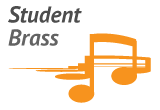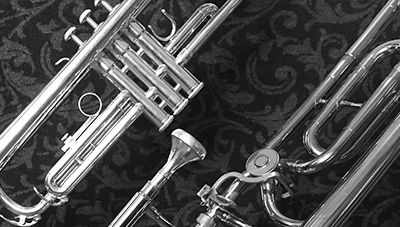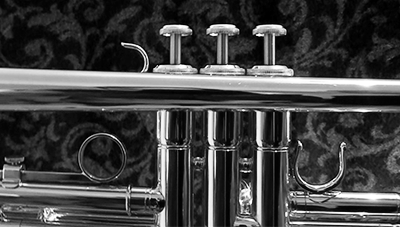This page provides supporting material for teaching semibreves, minims and crotchets, as well as introducing the concepts of improvisation and sight reading. Students with treble clef instruments will be learning the notes C and B (low range), or G and F# (mid range). Bass clef instruments learn Bb and A (low range) or F and E (mid range).
For ideas and suggestions on getting the most from this material, see the teachers’ notes.
TEACHERS' NOTES - LEVEL 1
We hope that our material is fairly self-explanatory, and that you can easily construct your own lessons around it, but here are some suggestions and additional information which you might find useful.
The lesson boxes on this page – like all the boxes on the site – are colour-coded. The orange ones are for treble clef instruments, while the teal coloured ones are for bass clef. Boxes which cater for all instruments, allowing bass and treble clef instruments to play together, are shown by a blend of orange and teal.
For this level, we provide ‘Low’ and ‘Mid’ versions of some of the exercises. This is because beginners are often only comfortable in either the lower or higher ranges of their instrument, and it is important that both groups are able to feel that they are succeeding from the outset.
The exercises follow the same pattern: the title identifies the learning outcome, there’s a brief instruction and then usually a video-based exercise. The icons in the bottom right-hand corner of each video allow you to switch to full screen mode and also change the tempo.
FINDING THE NOTES
This exercise is the first in which the whole class attempts to play at the same pitch together. It is also an opportunity for you to identify which of your students are most comfortable in the low range and which find mid range easier. It is vitally important that they can see themselves starting to succeed in one of these ranges, and understand that it’s ok to struggle with the other one at this stage.
Start with the Bb backing track. The highlighted instruments should play first, attempting to match the pitch they are hearing. Then all the other instruments can join in, attempting the same pitch using the fingering shown beneath the notes. Scroll down to repeat the exercise with the other backing tracks if you have Eb and F instruments in your class.
This exercise can look complicated at first sight, but the directions included in the videos should make everything clear. The class is likely to become bored and fidgety if the different sections are made to wait too long for their turn to play, so the aim is to enable everyone to be actively involved for most of the time. Book page 1
SEMIBREVES, MINIMS & CROTCHETS
This is a fun piece performed without instruments, to help students internalise the rhythmic values. You might want to use the Kodály rhythm method for this. As there is no pitch notation, this exercise is not in the books.
TIME SIGNATURES
This exercise is also a good opportunity to talk about bars, bar lines, accents, the first beat of the bar and whole bar rests. Follow the prompts in the videos. This exercise is not in the books.
IMPROVISING
We believe that students should be introduced to the idea of improvisation from the very beginning – even when they only know 2 notes. If this happens, they won’t be daunted when required to improvise later in their musical careers.
We suggest playing the backing track and encouraging everyone to experiment at the same time, even though it will sound terrible! After that, you can get them to play their ideas singly or in small groups, or perhaps playing around a circle, with each student taking just 2 bars before the next one takes over. As there is no notation, this exercise is not in the book.
SEMIBREVES, NOTES & RESTS
The learning outcomes are to play 2 notes, correctly identifying the pitch, and to revise semibreves and whole bar rests, aiming for complete silence during the rests.
Treble clef books: these exercises are on pages 2 and 3. Pages 2b and 3b are bonus extras, not on the website, that enable the treble clef instruments to play together.
Bass clef books: these exercises are on pages 2 and 3.
MINIM NOTES & RESTS
The learning outcomes are to understand the time signature of 4/4, plus minim notes and rests.
The treble clef boxes include a tutti version to enable playing together in harmony for the first time. Bass clef instruments can join in using their books.
Treble clef books: these exercises are on pages 4 and 5. The tutti version is on page 5b.
Bass clef books: these exercises are on pages 4 and 5.
CROTCHETS – 2 NOTE WALTZ
The learning outcomes are to understand the time signature of 3/4, and to use crotchets and crotchet rests. Treble and bass clef books: page 6 for Low and 7 for Mid.
THE LONG NOTE CHALLENGE
This exercise does what it says on the tin! It is repeated at various points in the course. The count in at the start is good practice for coming in on time at the start of a piece. Each student is responsible for noting the time they have achieved – there is a chart for them to make a note of this, available on the downloads page. The focus should be on whether a student is doing better each time, so that even low achievers have a sense of progression. This exercise is not in the books.
PLAYING IN PARTS – SKATERS’ WALTZ
The first two boxes allow the students to practise the parts for their own clef, and then all the parts come together in box three. Draw attention to the repeat marks. Book Page 8.
PERFORMANCE – LENTO
All the levels finish with a performance piece which showcases what has just been learned. This one provides practice in observing whole bar rests. Book page 9.
From here onwards, there are no separate Low and Mid parts, as students will have developed better control of their embouchure, and should all be able to play in the low range.
These notes are available as a pdf from the Downloads page.
FINDING THE FIRST NOTES
Book page 1
Find the box for your instrument.
Listen to each note and try to match the pitch in the gap which follows.
The highlighted boxes show the notes for this level, but try the others as well.
Repeat this in the other keys below.
LEVEL 1 CHALLENGE
To understand time signatures
Follow the prompts in each video – these exercises are not in the books
LEVEL 1 CHALLENGE – TO BUZZ SEMIBREVES, MINIMS & CROTCHETS ON THE MOUTHPIECE
This exercise is not in the books
1st time – move according to the rhythm notation
2nd time – buzz the rhythms on your mouthpiece
LEVEL 1 CHALLENGE – TO IMPROVISE & COMPOSE USING 2 NOTES
This exercise is not in the books
Listen to the backing track and play your own 2 bar tune
Treble and bass clef instruments – open position and 2nd valve
Trombones – 1st and 2nd positions
LEVEL 1 CHALLENGE – TO PLAY 2 NOTES AS SEMIBREVES
LEVEL 1 CHALLENGE – TO PLAY 2 NOTES AS SEMIBREVES
LEVEL 1 CHALLENGE – TO PLAY 2 NOTES AS SEMIBREVES
Play in the low range of your instrument
LEVEL 1 CHALLENGE – TO PLAY 2 NOTES AS SEMIBREVES
Play in the mid range of your instrument
LEVEL 1 CHALLENGE – TO PLAY C & B AS MINIMS
Scroll down for the tutti version –
Bass clef instruments can join in with their low range notes
LEVEL 1 CHALLENGE – TO PLAY G & F# AS MINIMS
Scroll down for the tutti version –
Bass clef instruments can join in with their mid range notes



